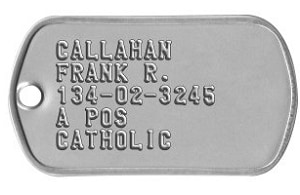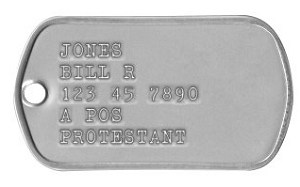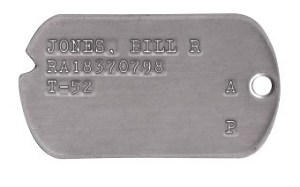Making It Official
The first official request to outfit service members with ID tags came in 1899 at the end of the Spanish-American war. Army Chaplain Charles C. Pierce — who was in charge of the Army Morgue and Office of Identification in the Philippines — recommended the Army outfit all soldiers with the circular disks to identify those who were severely injured or killed in action.
It took a few years, but in December 1906, the Army put out a general order requiring aluminum disc-shaped ID tags be worn by soldiers. The half-dollar size tags were stamped with a soldiers name, rank, company and regiment or corps, and they were attached to a cord or chain that went around the neck. The tags were worn under the field uniform.
The order was modified in July 1916, when a second disc was required to be suspended from the first by a short string or chain. The first tag was to remain with the body, while the second was for burial service record keeping. The tags were given to enlisted men, but officers had to buy them.
The Navy didnt require ID tags until May 1917. By then, all U.S. combat troops were required to wear them. Exact size specifications were put in place, and the tags also included each mans Army-issued serial number. Toward the end of World War I, American Expeditionary Forces in Europe added religious symbols to the tags — C for Catholic, H for Hebrew and P for Protestant — but those markings didnt remain after the war.
Slight Differences
During World War I, Navy tags were a bit different than Armys. Made of monel — a group of nickel alloys — they had the letters “U.S.N.” etched on them using a specific process involving printers ink, heat and nitric acid. If you were enlisted, the etching included your date of birth and enlistment, while officers included their date of appointment. The biggest difference was the etched print of each sailors right index finger on the back, which was meant to safeguard against fraud, an accident or misuse.
According to the Naval History and Heritage Command, the ID tags werent used in between World War I and World War II. They were reinstated in May 1941, but by then, the etching process was replaced with mechanical stamping.
Meanwhile, the Marines had been required to wear ID tags since late 1916. Theirs were a mix of the Army and Navy styles.
Military Dog Tag Information By the Years
Dog tags can look a bit different depending on the time or “era” that they were worn.

The dog tags were issued with a social security number. Dog tag Army, specifically, were issued to the US Army, Army Reserve, Army National Guard, Department of the Army, and other civilian personnel that is authorized, including ones overseas.
The will display the wearer’s last name, first name, middle initial, name suffix, social security number, blood type, and religion, to look something like this:
Note: Blood type is O, A, B, AB, and POS or NEG not + or – signs.

In terms of design, the Vietnam era do tags had a rolled edge as well as a hole on the left. The text is debossed, featuring the same information as the 195 – 2015 time period.

This was during the Korean War. The tags were also rounded in the edges. There was debossed text along with a notch. The information, however, is slightly different. Aside from the wearer’s last name, first name, middle initial, blood type, and religion, their service prefix and number are included, as well as tetanus toxoid shot year.
These are commonly referred to as the World War II dog tags. They also contain a notch, which is used to position the tag in transcription tools. Medics used these to quickly transfer the wearer’s information onto medical paper forms or burial records.
Fun Fact: The notches were usually called “tooth notches” by soldiers.
Up until 1939, the tags were round and had an aluminum build or monel build. The information was stamped on and limited information because of its shape and size.
In 1940, the tag displayed the wearer’s name and serial number on the top two lines. Then, the emergency contact information, next of kin’s name, address, city, and state in lines three to five.
Towards the end of 1941, medical information, including blood type and tetanus shot year, was added to the second line. This was to assist medics in the field. During this time, the wearer’s religious preference was also added.
In 1943, the emergency contact information was taken off the tags. This was because a few soldiers were deployed overseas, and information about next of kin’s name, address, city, and state can be used against captured personnel as threats.
Finally, in 1944, a standard layout was set for last name, first name, and middle initial.
What are dog tags
There is no term linked as closely to military service as the term “dog tag.” It is synonymous with the military and for hundreds of years these emblems of sacrifice and service have etched their place into American military culture.
Over the years, much like the uniforms and equipment worn and used by service personnel, dog tags have changed and what goes on military dog tags has also changed. In order to understand what goes on military dog tags today, we have to understand what information has been placed on them in the past. Like the soldiers who wear them, dog tags have evolved over the years.
Civil War During the Civil War, some battles had casualties numbering in the thousands and soldiers became afraid that they would not be identified if they were killed in action. They wanted to be properly identified and buried in a marked grave if they died, so naturally, military ingenuity kicked in and soldiers devised ways to be identified if they were killed.
What goes on military dog tags during the Civil War? That’s a hard question to answer since there was no uniformity, but back then primarily soldiers stitched their names into their uniforms while others pinned pieces of paper to themselves. Many more used coins or other bits of metals and some men carved their names into chunks of wood strung around their necks. Soldiers with financial resources purchased engraved metals tags from vendors who followed the armies during the war.
When the Civil War ended, more than 40 percent of the Union Army’s dead were unidentified, according to the U.S. Defense Department. The soldiers’ concerns were validated and the use of dog tags on the battlefield took root in military history. Early 1900sAccording to the U.S. Department of Defense, the first official request to issue service members with dog tags was in 1899 at the end of the Spanish-American war. U.S. Army Chaplain Charles C. Pierce, who was in charge of the Army Morgue and Office of Identification in the Philippines, recommended that all soldiers be issued circular disks to identify those who were severely injured or killed in action.
By 1906, the Army required that dog tags be worn by soldiers and thus the Army ushered in a new chapter in military dog tags history. But what goes on military dog tags in the 1900s? The dog tags were stamped with a soldiers name, rank, company and regiment or corps. The tags were worn around the neck with the field uniform, secured by a chain or cord.
Ten years later, the original dog tag order was modified and a second identical disc was required to be worn. The first dog tag would remain with the body of the fallen soldier, while the second was for burial service record keeping.
In 1917, when the U.S. Navy required all their sailors wear dog tags, the War Department finally mandated that all American combat troops have dog tags. Certainly, back then military leaders were asking themselves, “what goes on military dog tags?” So, they decided the tags included the service member’s name, serial number and religious denomination to help with the disposition of remains. The Army, Navy and Marine Corps all had their own variety of dog tags.
World War II and Korean WarSome believe that the term dog tag was a nickname that World War II military draftees called the tin tags because the draftees joked that they were treated like dogs. Another military rumor is that they looked like tags on a dog’s collar. But while the term “dog tag” seems to have caught on around World War II, the concept of identifying soldiers originated long before World War II. During World War II, dog tags did not change much and they became part of the uniform evolving into the size and shape they are today. What goes on military dog tags from the World War II era? The tags were engraved with the name, rank, service number, blood type and religious preference. The name and address of next of kin was also included, as well as immunization information, but that information eventually was removed from dog tags after the war. That’s a lot of information in a little space. Vietnam and beyond Dog tags for decades had notches on them. Despite the untrue reasoning for this notch covered in a previous Depot Blog post, the notches existed because of the type of machine used to create them and by the 1970s, those machines became obsolete and the notched dog tags assumed their rightful place in history. What goes on military dog tags from the Vietnam Era? The usual; name, serial number, blood type and religious denomination.
Today, dog tags continue to be issued and they are an important part of battlefield identification. Dog tags at some point transitioned from using serial numbers to social security numbers, and that lasted more than 40 years until 2015 when the services began to remove social security numbers over privacy concerns.
What goes on military dog tags today? Name, blood type, religious denomination, but some still have social security numbers on them. While what goes on military dog tags is the same across the service branches, the information is placed in different order depending on the service branch.
Conclusion Dog tags were developed at a time when American warfighters desired to be properly identified should they fall in battle. They wanted their ultimate sacrifice to be known. That same purpose has carried on for decades, ensuring the proper and dignified processing of American fallen warriors.
Today, with advancements in DNA science and technology, what goes on military dog tags seems less important, but dog tags are still as much of military culture as they have ever been.